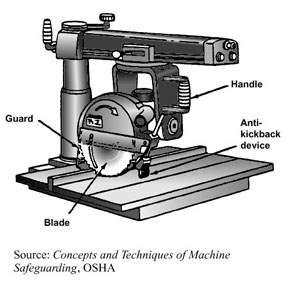
Woodworking processes often require the use of machines to cut and manipulate wooden workpieces. In the past, radial arm saws were a popular choice among carpentry workers. As shown in the image to the left, it features a circular blade affixed to a handle. Using a radial arm saw, carpenters can easily cut and shape wooden workpieces. So, what is a radial arm saw exactly, and how does it work in woodworking and carpentry applications?
Overview of Radial Arm Saws
Originally invented in the early 1920s by Raymond DeWalt, a radial arm saw is a woodworking machine that’s designed to cut and shape wooden workpieces. It features a circular saw blade that’s mounted radially on a stable platform. There’s a handle on the side, as well as a guard to protect the worker from injury during use.
Advantages of Using a Radial Arm Saw
Radial arm saws were popular for many decades following their inception in the 1920s. They feature a simple design that allows carpenters to quickly and efficiently cut wooden workpieces. At the time, power tools for cutting wood were limited at best. The radial arm saw solved this problem by offering an easy-to-use solution. Driven by an electric motor, it allowed carpenters to quickly cut wooden workpieces.
Another advantage of using a radial arm saw its ability to perform both miter and rip cuts. During the 1970s, the miter saw became a popular and well-known woodworking tool. Unlike the radial arm saw, however, the miter saw doesn’t support rip cuts; it’s only able to perform miter cuts. The radial arm saw can perform a variety of cuts, including both miter and rip.
Disadvantages of Using a Radial Arm Saw
On the other hand, radial arm saws suffer from potentially serious disadvantages, which has ultimately led to their downfall. When compared to table saws, for example, radial arm saws are typically more expensive. The high cost makes them an unattractive choice for both commercial and consumer woodworking applications.
Radial arm saws also require extra work to maintain. If the blade becomes dull, it may drive itself into the wooden workpiece during operation. While they work well for cutting plywood and other thin sheets of wood, radial arm saws aren’t effective at cutting lumber. Thick pieces of lumber typically require a different woodworking machine. If the blade is lowered too far, it may cut through the table on which the radial arm saw is placed.
No tags for this post.